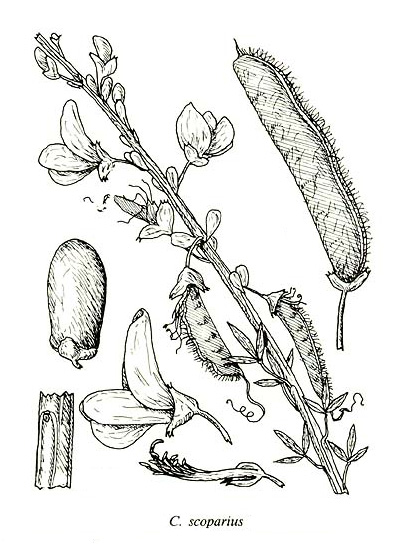Family: Fabaceae
Cytisus scoparius
Citation:
Link, Hort. bot. Berol. 2:241 (1822).
Synonymy: -Spartium scoparium L., Sp. Pl. 709 (1753); Sarothamnus scoparius (L.)Wimmer ex Koch, Syn. Fl. Germ. Helv. edn 1, 1:152 (1836).
Common name: English broom, common broom.
Description:
Much branched shrub, to 200 (rarely to 250) cm high; branches erect, ascending or procumbent, green, usually leafy, 5-angled, glabrous or sericeous when young; leaves usually 3-foliolate, petiolate to subsessile, but 1-foliolate and sessile on young twigs, leaflets elliptic-oblong to obovate, 6-20 x 1.5-9 mm, with appressed hairs or glabrous; stipules inconspicuous.
Flowers axillary, solitary or in pairs; pedicel twice as long as the calyx; bracts leaf-like or triangular, 1-2 mm long, green-brown, softly-scarious; bracteoles absent; calyx broadly campanulate, c. 5 mm long, with 2 divaricate lips, many-veined, glabrous, persistent in fruit; petals golden-yellow, standard reniform, 16-20 mm long and broad; keel longer, deflexed; ovary and base of style hairy; style long, curved into a circle, with a small capitate stigma.
Pod shortly stalked, narrow-oblong in outline, 25-40 x 8-13 mm, strongly compressed, villous along the sutures, with 6-15 seeds; seed ovate-cordate, 2.5-3.5 x 2-2.5 mm, laterally compressed, green-yellow, smooth, shiny; aril flat, U-shaped, yellow-brown.

| Cytisus scoparius twig, flower, flower with petals and part of calyx removed, ridged brange, legume and seed.
|
Image source: fig 381b in Jessop J.P. & Toelken H.R. (Ed.) 1986. Flora of South Australia (4th edn).
|
Published illustration:
Parsons (1973) Noxious weeds of Victoria, figs 183-185; Ross-Craig (1954) Drawings Brit. Pl. 7:t. 8.
|
|
Distribution:
|
S.Aust.: NL, SL. N.S.W.; Vic.; Tas. New Zealand. Native to North Africa and Spain, occurs in Europe, the Middle-East and southern Asia.
|
Conservation status:
naturalised
Flowering time: Aug. — Nov.
|

SA Distribution Map based
on current data relating to
specimens held in the
State Herbarium of South Australia
|
Biology:
No text
Author:
Not yet available
|

